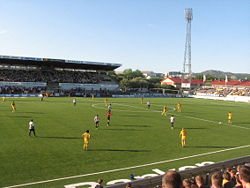
Back Aspmyra-Stadion German Aspmyra Stadion Spanish ورزشکاه آسپمیرا Persian Aspmyra Stadion French Aspmyra Stadion Italian アスプミラ・スタディオン Japanese Aspmyrastadion Dutch Aspmyra stadion NN Aspmyra stadion NB Aspmyra Stadion Polish
 | |
 | |
| Location | Bodø, Norway |
|---|---|
| Coordinates | 67°16′36″N 14°23′4″E / 67.27667°N 14.38444°E |
| Owner | Bodø Municipality |
| Operator | Bodø/Glimt |
| Executive suites | 15 |
| Capacity | 8,270[1] |
| Record attendance | 12,189 |
| Field size | 105 x 68 m |
| Surface | Artificial turf |
| Scoreboard | LED video display |
| Construction | |
| Broke ground | 1964 |
| Opened | 1966 |
| Renovated | 1980, 2008 |
| Expanded | 1999–2001 |
| Construction cost | NOK 140 million (1999–2001) (estimated) |
| Tenants | |
| Bodø/Glimt Grand Bodø | |
Aspmyra Stadion is a football stadium in the town of Bodø in Bodø Municipality in Nordland county, Norway. Home of Bodø/Glimt and Grand Bodø, it holds a seated capacity for 8,270 spectators. The venue has four stands: a modern all-seater with roof, 100 club seats and 15 luxury boxes to the south, unroofed all-seater stands to the east and west and two stands to the north. An older raised grandstand with roofing at the back and a new (built 2022) all-seater unroofed stand in front. Before this new stand was built the area in front of the old stand was a standing area that could hold approximately 2000 people, but did not fulfill UEFA safety regulations for international matches. The venue has floodlights and artificial turf with under-soil heating. Immediately south of the venue lies Aspmyra kunstgressbane, a training pitch with artificial turf. Aspmyra Stadion has hosted one Norway national football team match, against Iceland in 2002.
The venue opened in 1966 as a municipal multi-purpose stadium which included a running track. Glimt reached the top-flight in 1977, and played Cup Winners' Cup matches in the late 1970s at Aspmyra. The venue had a slight upgrade in 1980, which also saw the laying of all-weather running track and the construction of the training pitch. In 1992, the pitch was resowed, forcing Glimt to play a season in Nordlandshallen, which since has been used twice for Norwegian top division matches. Aspmyra Stadion was sold to Glimt in 1997, followed by the construction of the south and east stands. This involved removing the running track and building commercial and residential properties around the venue. Artificial turf was laid in 2006. After the club received illegal public subsidies in 2008 and had to upgrade the venue, it was in 2011 sold back to the municipality.
- ^ "Nye tribuner klare til bruk på Aspmyra". nrk.no (in Norwegian). NRK. Retrieved 6 April 2022.